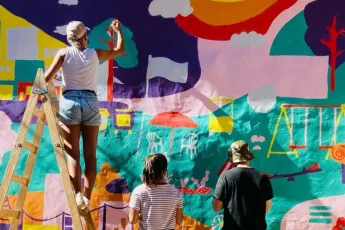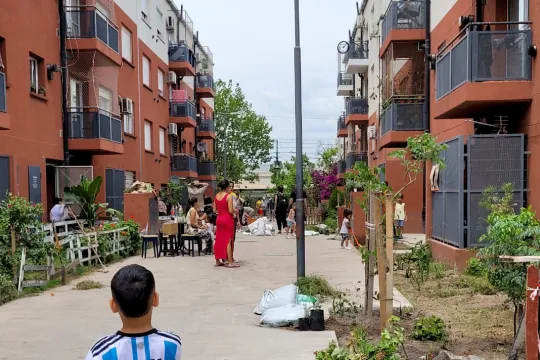
© Silvana Marchetti
Within the scope of the TUC interventions, and in conjunction with the School of Architecture, Design and Urban Planning - UBA, a collective action took place seeking not only to beautify the streets of Barrio 20 but also to change the way in which the community perceives its environment.
In the context of the Morphology II course (Pereyra chair) of the Graphic Design academic programme, the students were given the challenge of creating, as a practical exercise, two murals in different sectors of Barrio 20 that demonstrate the essence of the neighbourhood.
“On the day of their visit to the school, the local representatives of the neighbourhood presented the project together with representatives of the TUC project. The conversation was very clear and interesting! They told us about the neighbourhood and the different interventions that have been carried out in recent years. The idea was that, based on this information, and collectively, we would investigate the problems and needs of the community. We would then develop a vision demonstrating values that contribute to local improvement, with environmental sustainability and climate change as our main focus” explains Bianca, a student at FADU.
The different groups looked for activities, axes and concepts that belonged to the community of Barrio 20 and that caught their attention for their potential to be represented in a graphic and illustrative language, as the idea was for the murals to be located in strategic places in the neighbourhood – each one addressing a topic relevant to the community. The teams worked on their proposals, capturing the ideas on paper to later transfer them to the neighbourhood walls. We noticed that the projects had something in common: they all highlighted community work.
The next stage took place in March of this year, with the actual painting of murals on the walls. First, the designs were projected on the walls at night, so that the painting could take place during the day; the idea was to trace the designs on the walls, providing a better idea of the shapes and illustrations.
On the two final weekends, groups of teachers, students and local leaders joined the work and added the final touch to the murals: the colors. Over four long days, more than 30 people participated in the intervention, helping to bring the murals to life.
“The premise and intention of the exercise was that the walls could talk about the neighbourhood, showing situations that represent the residents, their values and their continuous work.”
“It was a beautiful experience; we believe it is important to transmit to our students that our career and studies only make sense if we connect with the outside world, with society. And this is a small contribution, just a grain of sand that allows residents to walk by and recognize themselves in the mural, and feel both capable of doing it and represented in it. That connection is essential; it motivates us to continue making experiences and creating spaces where people connect, making them feel part of something.” says Maru, course professor.
